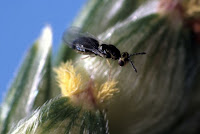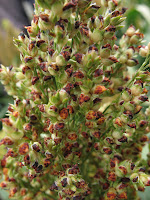Bring on NPV against grubs on grain sorghum
 Every year caterpillars of the corn earworm (helicoverpa), Helicoverpa armigera, cause losses to sorghum crops. Regular inspection during flowering is important to detect caterpillar infestations and properly time control measures.
Every year caterpillars of the corn earworm (helicoverpa), Helicoverpa armigera, cause losses to sorghum crops. Regular inspection during flowering is important to detect caterpillar infestations and properly time control measures.
Pre-flowering heads of grain sorghum are very attractive to egg-laying moths of the corn earworm. On any individual head, most eggs are laid prior to the start of flowering, as indicated by the presence of yellow anthers.
By the end of flowering, when brown anthers are present at the base of the head, eggs will have hatched and most larvae will be less than 7 mm in length.
A timely spray application of the naturally occurring biopesticide NPV (nucleopolyhedrovirus) remains the best control option for grain sorghum crops under attack from corn earworm.
NPV performs exceptionally well on grain sorghum, with well timed sprays usually achieving greater than 90 per cent control while leaving beneficial parasites and predators to mop up survivors.
If the spread of flowering in a crop is large, it may be better to spray earlier rather than wait until 50% of the crop is at the brown anther stage. This is because caterpillars on the earliest flowering heads may be larger than the ideal size to target with NPV, and they will cause some damage if not adequately controlled with NPV.
Research has shown that early application of NPV creates a disease outbreak and secondary NPV infection will control most caterpillars on late flowering heads.
Other issues to ensure good results with NPV
Water quality
Water used in spray mixes should have a pH of 7. Alkaline water will seriously reduce the performance of NPV, so buffer water with Li700 or equivalent to neutralise pH.
Water volumes
For high-volume, water-based sprays, a minimum of 30 L water/ha is recommended for aerial application, and 100 L water/ha for ground rig application. Coverage
Coverage
NPV must be ingested to be effective, so the challenge is to achieve good coverage of the target. This means paying particular attention to water volumes, nozzles, operating pressure, weather conditions, etc. You want to spread NPV over as much of the head as possible to ensure caterpillars have a high chance of picking up a lethal dose as they feed on the head.
Additives
Additives such as Amino Feed, etc. are not recommended when NPV is applied to grain sorghum.
Paying attention to the detail will ensure the best results from NPV.
Article by Dr. Dave Murray
New Beat Sheet contributors
The beat sheet blog team has been expanded and includes two new contributors, Kate Charleston and Zara Ludgate.
Kate is the development extension officer with the entomology team in Toowoomba. Her role is to provide information about IPM in field crops as well as training to growers and industry in managing insect pests according to IPM principles. Kate joined entomology in June 2008 and has previously worked as a research scientist, agronomist, plant health inspector and extension officer. She started her career with the Department of Primary Industries in Tasmania and joined the Queensland Government in 1999 as an extension officer in a sugar project at South Johnstone in Far North Queensland. Kate has worked with sugarcane, cotton and pulse crops and has considerable training and extension experience.
Kate joined entomology in June 2008 and has previously worked as a research scientist, agronomist, plant health inspector and extension officer. She started her career with the Department of Primary Industries in Tasmania and joined the Queensland Government in 1999 as an extension officer in a sugar project at South Johnstone in Far North Queensland. Kate has worked with sugarcane, cotton and pulse crops and has considerable training and extension experience.
Zara has just started her career in entomology research. She comes from a rural background and completed a degree in plant and soil science at St Lucia, Brisbane in 2007. For her honours year she investigated the effect of a plant defence compound on the fitness of diamondback moth. While in Brisbane she provided technical support for research into bio-pesticide production for helicoverpa and green vegetable bug management. She is now based in Toowoomba with the crop protection systems - entomology unit. Her current research interests include insecticide resistance in whitefly and integrated pest management in grain crops.
While in Brisbane she provided technical support for research into bio-pesticide production for helicoverpa and green vegetable bug management. She is now based in Toowoomba with the crop protection systems - entomology unit. Her current research interests include insecticide resistance in whitefly and integrated pest management in grain crops.
Labels: helocoverpa, NPV, Sorghum






 The yield loss estimates in the table assume that spraying results in a 100% kill and that there is no midge damage prior to chemical application. It also assumes that you will receive the same average midge pressures over 4-5 days. In reality research has shown that one well timed insecticide for midge (put on from panicle emergence and before midge even enter the crop) will still only prevent 70-80% damage protection in lower rated sorghum hybrids. In 8 rated hybrids, yield losses can be reduced by over 90% with this spray timing.
The yield loss estimates in the table assume that spraying results in a 100% kill and that there is no midge damage prior to chemical application. It also assumes that you will receive the same average midge pressures over 4-5 days. In reality research has shown that one well timed insecticide for midge (put on from panicle emergence and before midge even enter the crop) will still only prevent 70-80% damage protection in lower rated sorghum hybrids. In 8 rated hybrids, yield losses can be reduced by over 90% with this spray timing.













